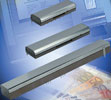Highly accurate pattern recognition sensors
23 January 2008
Opto-Electronics

Murata has released four new products in its BS05 series of magnetic pattern recognition sensors. The BS05M1HFAL, BS05M1KFCA, BS05M1KFFA and BS05M1KFBB magneto-resistive sensors are designed for ATMs, banknote counters, detectors and other validation applications.
The devices are suitable for detection of magnetic thread or magnetic ink, and enable simple and quick mounting. They retain around 70% of their output voltage at a 0,1 mm gap between sensor and substrate, compared to just 4% for typical coil head sensors. Along with their stable frequency characteristic, which is independent of the scanning speed, this makes them suitable for high-speed processing devices that demand high accuracy.
Magneto-resistive sensors consist of a permanent magnet and two sensing elements to ensure compensation for changes in temperature. When a magnetic material is passed over the sensor, the elements detect a change in the magnetic flux density, which is converted into an electrical signal. In banknote validation applications, the sensor is typically mounted beneath a pressure roller which helps keep the banknote in contact with the sensor's surface. In Murata's multichannel devices, multiple sensors are mounted next to each other, to allow magnetic pattern recognition over the whole width of a banknote.
The BS05M1HFAL is an 8-channel sensor with channel width of 3 mm, while the BS05M1KFFA has 13 channels, each 10 mm wide. Both have all their channels mounted in a straight line. This layout is especially useful in banknote validators that use a pressure roller, as the centre of the roller can be directly above the line of sensing elements, leading to lower signal loss and eliminating time differences between signals. The in-line layout also eases handling and PCB assembly and reduces the size of the pressure roller and sensing assembly.
The BS05M1KFCA six-channel and BS05M1KFBB 13-channel sensors have 10 mm channel widths with channels offset in alternate directions to make a zigzag style configuration. This ensures there is no physical gap between each channel, leading to very reliable detection of banknotes. These sensors are therefore targeted at high end machines that have high scanning speed and require high detection reliability.
Further reading:
Africa’s future internet could be on overland submarine cables
Opto-Electronics
SEACOM aims to explore an innovative new concept: utilising submarine cable technology to address the longstanding challenges in Africa’s terrestrial infrastructure.
Read more...
Versatile range of camera modules
EBV Electrolink
Opto-Electronics
The CAM-66GY pro-modules from ST are a full range of sample camera modules made for a seamless evaluation and integration of the VD66GY 1,5-megapixel colour image sensor.
Read more...
Enhanced breaker status and communication module
Schneider Electric South Africa
Opto-Electronics
Schneider Electric has announced the launch of its new Breaker Status and Communication Module (BSCM) Modbus SL/ULP, which delivers enhanced performance, improved connectivity, and simplified integration for power distribution systems.
Read more...
Heat-resistant LEDs
Opto-Electronics
Würth Elektronik’s new RGB LEDs are characterised by excellent heat resistance with an insensitivity to temperatures from -40 to 100°C making them ideal solutions for reliable, colour-variable lighting in applications at high operating temperatures.
Read more...
PhotoMOS relays
Future Electronics
Opto-Electronics
The AQY221R2SX and AQY221R2S PhotoMOS from Panasonic Industry ensures excellent characteristics and high-speed switching performance.
Read more...
Mouser now shipping onsemi’s image sensors
TRX Electronics
Opto-Electronics
The AR0145CS is a 1/4,3-inch CMOS digital image sensor with a 1280 (H) x 800 (V) active-pixel array that can capture both continuous video and single frames.
Read more...
Adaptive optics’ power solution
Altron Arrow
Opto-Electronics
Vicor power-dense adaptive optical modules enable colossal telescopes to look into the past for deep space discoveries.
Read more...
Ultra-high speed photo detection
Opto-Electronics
TDK Corporation has announced a photo-spintronic conversion element combining optical, electronic, and magnetic elements that can respond at an ultra-high speed of 20 picoseconds.
Read more...
High-speed lasers
RFiber Solutions
Opto-Electronics
Macom are a high-volume manufacturer of lasers, deploying more than 100 million devices with a reliability of less than 50 FIT and greater than 100 years of wear-out lifetime
Read more...
High-performance optical interconnect
Opto-Electronics
STMicroelectronics has unveiled its next generation of proprietary technologies for higher-performing optical interconnect in datacentres and AI clusters.
Read more...


